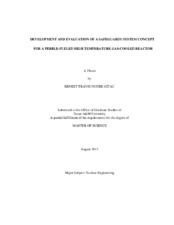| dc.description.abstract | Pebble-fueled high temperature gas-cooled reactor (HTGR) technology was first developed by the Federal Republic of Germany in the 1950s. More recently, the design has been embraced by the People's Republic of China and the Republic of South Africa. Unlike light water reactors that generate heat from fuel assemblies comprised of fuel rods, pebble-fueled HTGRs utilize thousands of 60-mm diameter fuel spheres (pebbles) comprised of thousands of TRISO particles.
As this reactor type is deployed across the world, adequate methods for safeguarding the reactor must be developed. Current safeguards methods for the pebble-fueled HTGR focus on extensive, redundant containment and surveillance (C/S) measures or a combination of item-type and bulk-type material safeguards measures to deter and detect the diversion of fuel pebbles. The disadvantages to these approaches are the loss of continuity of knowledge (CoK) when C/S systems fail, or are compromised, and the introduction of material unaccounted for (MUF). Either vulnerability can be exploited by an adversary to divert fuel pebbles from the reactor system.
It was determined that a solution to maintaining CoK is to develop a system to identify each fuel pebble that is inserted and removed from the reactor. Work was performed to develop and evaluate the use of inert microspheres placed in each fuel pebble, whose random placement could be used as a fingerprint to identify the fuel pebble. Ultrasound imaging of 1 mm zirconium oxide microspheres was identified as a possible imaging system and microsphere material for the new safeguards system concept.
The system concept was evaluated, and it was found that a minimum of three microspheres are necessary to create enough random fingerprints for 10,000,000 pebbles. It was also found that, over the lifetime of the reactor, less than 0.01% of fuel pebbles can be expected to have randomly the same microsphere fingerprint. From an MCNP 5.1 model, it was determined that less than fifty microspheres in each pebble will have no impact on the reactivity or temperature coefficient of reactivity of the reactor system. Finally, using an ultrasound system it was found that ultrasound waves can penetrate thin layers of graphite to image the microsphere fingerprint. | en |


